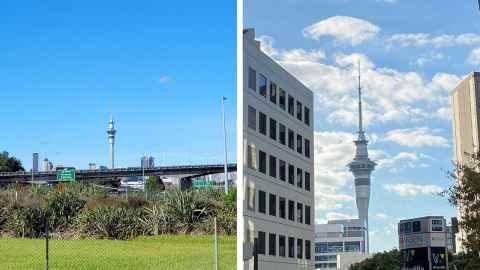Kiwi scientists investigate Sky Tower’s weird effect
8 January 2024
When a scientist noticed the Sky Tower appeared squat from close-up and tall from far away, he decided to investigate.

From close up, Auckland’s Sky Tower appears short and stumpy, from far-off it seems tall and thin, prompting researchers with an interest in visual perception to investigate.
A newly published paper finds the Sky Tower does indeed appear to be squat close-up and tall from far-away, says senior author Associate Professor Sam Schwarzkopf from the School of Optometry and Vision Sciences at Waipapa Taumata Rau, University of Auckland.
In addition, it appears taller when viewed from higher altitudes, such as the summit of Rangitoto.
“Our findings suggest the Sky Tower’s apparent height of squatness depends on distance, confirming our outgoing suspicions about this illusion.
“The effect could be related to phenomena like the Moon Illusion, whereby the moon appears larger when near the horizon than up in the sky,” Dr Schwarzkopf says. “This is thought to be because we misinterpret how far away it is.”
His interest in the topic was prompted by his own observations of the ‘weird effect’ when he arrived in the country and those of visitors to the city.
However, the findings have implications for building landmarks like the Sky-Tower.
“Architects and city planners want to achieve a particular perceptual effect and so it is important to better understand such perceptual effects.”
This study was run by Dr Schwarzkopf and four honours students to help him with a wider survey making geo-marked observations.
In a lab-based study, they showed 27 participants photographs of the Sky Tower from various Auckland vantage points and asked them to fill out a survey.
The next step would be further research on the topic by taking precise perceptual measurements or manipulating what people see, for example using virtual reality.
They hope to spark an international conversation on perceptions of landmarks.
“One motivation for the study was to learn if people reported similar perceptual fluctuations in other places,” Dr Schwarzkopf says.
“We have not heard of other cases, making the Auckland Sky Tower unique in that respect, for instance, nobody seems to experience the same phenomenon with the CN Tower in Toronto.
“By publishing this report, we may hear of other cases though.”
Dr Schwarzkopf leads a research group that aims to build understanding of how we perceive the world, primarily, but not solely, through vision.
By building understanding of perception, the group hopes to inform understanding of how the brain works in general – and thus reveal how neural processing differs in visual disorders, neurodegenerative illness, or conditions like schizophrenia.
In their previous research, they showed that what we see in visual illusions is related to the structure of each person’s brain, and compared the way the brain
interprets information in people with autism to neurotypical volunteers.
In this latest study, just published online in the journal Perception, they
conclude that the Sky Tower is much like a giant, the Scheinriese, in a children’s tale by Michael Ende, who appears to be a giant from afar but is a typical human close up.
Media contact
Jodi Yeats | Media adviser
M: 027 202 6372
E: jodi.yeats@auckland.ac.nz